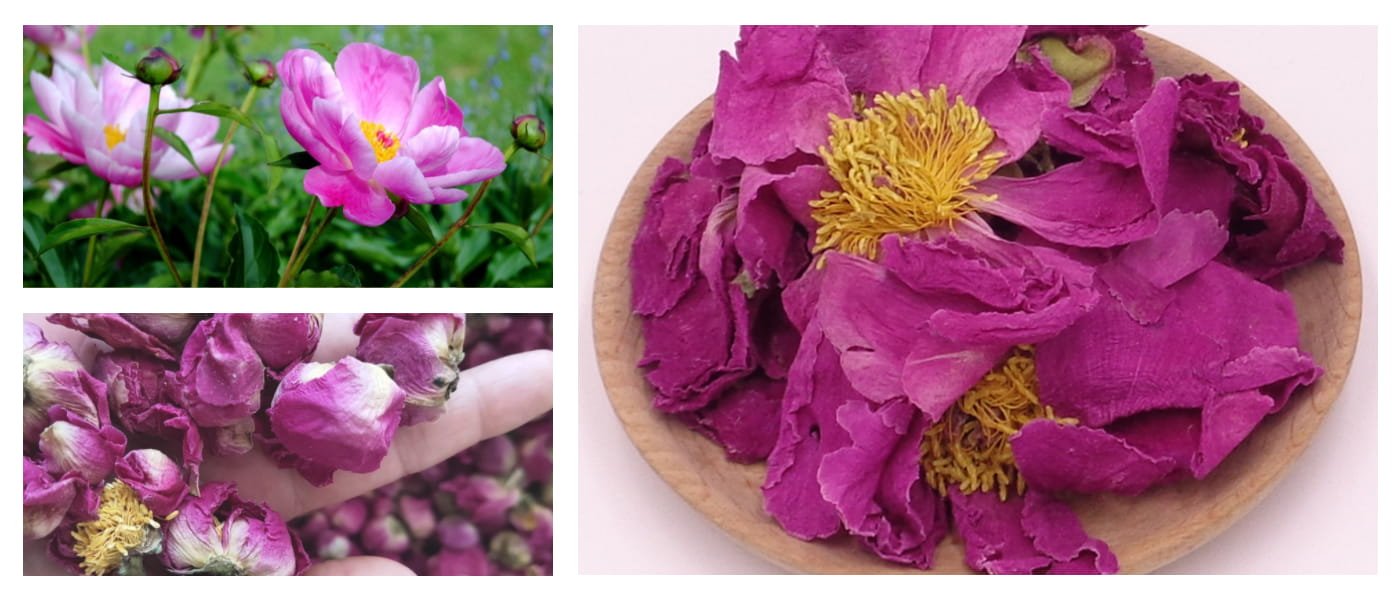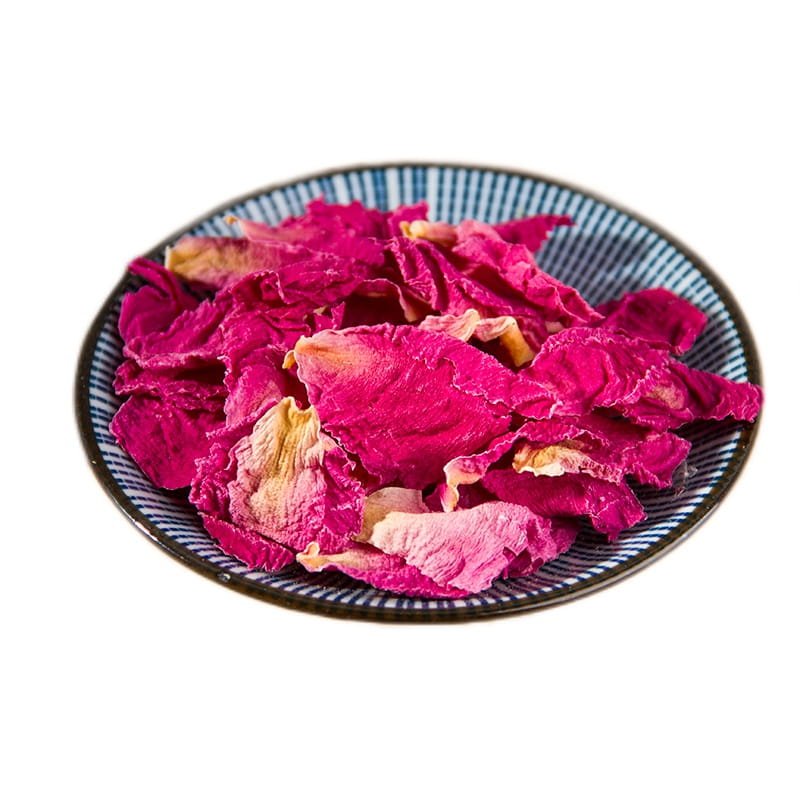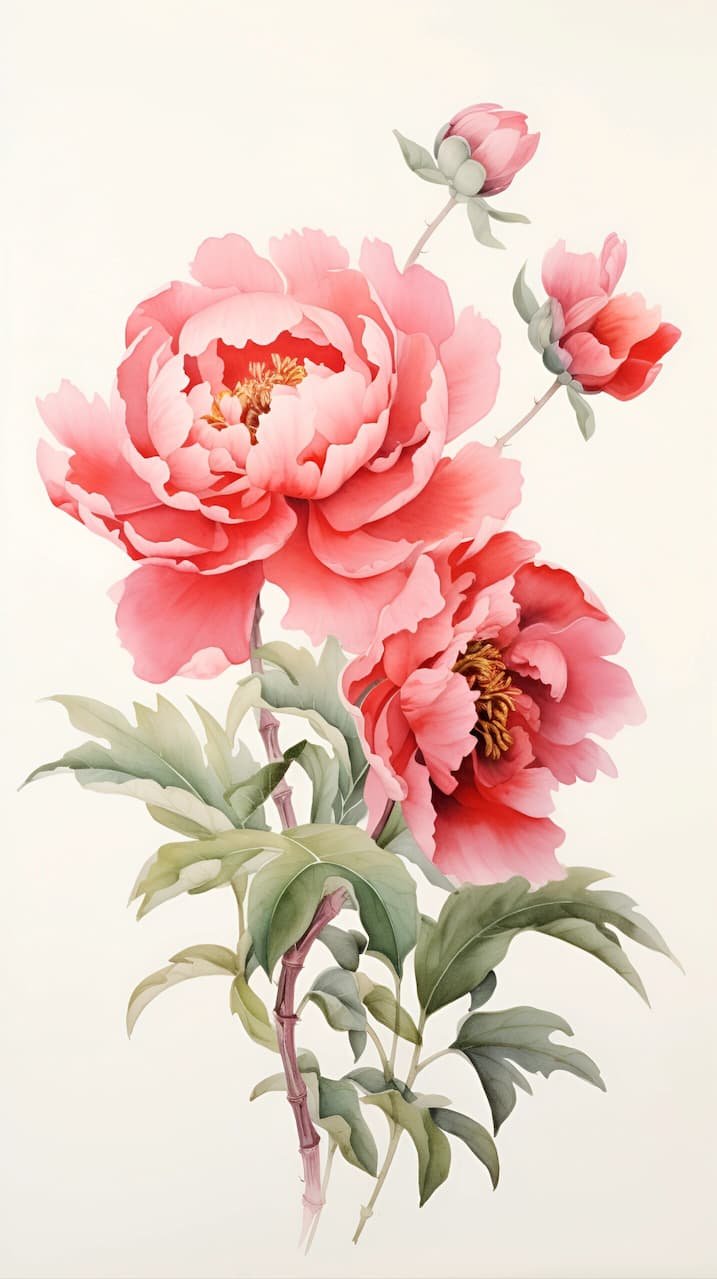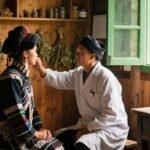Chinese Peony Flower (Paeonia lactiflora Flower, Shao Yao Hua)

What is Chinese Peony Flower (Shao Yao Hua)?
Chinese Peony Flower (Shao Yao Hua), known in Traditional Chinese Medicine (TCM), refers to the dried flower buds of Paeonia lactiflora Pall., a plant of the Ranunculaceae family.
Nature and Flavor: Bitter and sour in taste; neutral to slightly cold in nature.
Meridian Affiliation: It enters the Hand and Foot Taiyin channels, as well as the Jueyin and Shaoyang channels.
Functions: It promotes blood circulation and regulates menstruation.
Indications: It is mainly used to treat menstrual disorders such as amenorrhea, blood depletion syndromes, and abnormal vaginal discharge (both red and white).
What are the Benefits of Chinese Peony Flower (Shao Yao Hua)?
Traditional Functions
Chinese Peony Flower (Shao Yao Hua) possesses the functions of promoting blood circulation and relieving pain. It can improve microcirculation and alleviate circulatory blockages. In TCM theory, it is commonly used to treat gynecological conditions such as dysmenorrhea (painful menstruation), amenorrhea (absence of menstruation), and irregular menstrual cycles. It helps enhance uterine blood flow, alleviates menstrual cramps and sluggish flow, and supports the normalization of a woman’s physiological cycle.
Modern Pharmacological Effects
1. Anti-infective and Immune-Enhancing Effects
Chinese Peony Flower (Shao Yao Hua) exhibits antiviral, antibacterial, and anti-inflammatory activities. It can be used to treat skin infections, throat infections, and related illnesses. Rich in various bioactive compounds, it boosts the body’s immune response and enhances resistance against diseases. Modern medical studies confirm its significant anti-inflammatory effects, helping to inhibit and control inflammatory processes, which is important for preventing and treating various inflammatory diseases.
2. Antioxidant Effects
The flower is rich in vitamins and amino acids, making it valuable for beauty and skin care. It scavenges free radicals, reduces pigmentation, lightens dark circles under the eyes, and maintains skin elasticity. Additionally, it promotes metabolism and accelerates the elimination of toxins from the body, helping to preserve youthful, healthy skin.
How to Use Chinese Peony Flower (Shao Yao Hua)?
Internal Use
It can be used as a decoction, typically at a dosage of 5-12 grams. Alternatively, it can be ground into powder and made into pills or powder form for ingestion. When taking Chinese Peony Flower (Shao Yao Hua) internally, the dosage and course of (used in traditional contexts) should be determined based on individual conditions and under the guidance of a healthcare professional.
External Use
For external applications, Chinese Peony Flower (Shao Yao Hua) can be crushed and applied directly to the affected area to treat skin infections, boils, and abscesses. It can also be used as an infusion to wash affected areas. Careful attention to dosage and (used in traditional contexts) duration is necessary to avoid overuse.
Dietary Therapy
Chinese Peony Flower (Shao Yao Hua) can also be incorporated into daily diet therapy. The flowers can be brewed into tea, used in soups, or cooked with porridge. When consuming for health purposes, methods and dosage should be selected according to individual constitution and specific health needs.

Precautions and Side Effects
1. Pregnant and Lactating Women
Due to its medicinal properties, pregnant and breastfeeding women should avoid consuming or using Chinese Peony Flower (Shao Yao Hua) to (helps maintain) potential adverse effects on the fetus or infant.
2. Individuals with Cold Constitution
Because of its slightly cold nature, those with a cold or deficient constitution should refrain from using Chinese Peony Flower (Shao Yao Hua) to (helps maintain) exacerbating cold-related symptoms.
Modern Research and Applications of Chinese Peony Flower (Shao Yao Hua)
Modern research has revealed that Chinese Peony Flower (Shao Yao Hua) contains multiple bioactive compounds such as paeoniflorin, paeonolide glycoside, and benzoic acid, each playing significant therapeutic roles.
1. Paeoniflorin
Paeoniflorin is one of the primary active ingredients. Studies have demonstrated its potent anti-inflammatory, analgesic, sedative, and anticonvulsant effects. It also inhibits platelet aggregation, reduces blood viscosity, and improves microcirculation. Therefore, paeoniflorin shows promising applications in the (used in traditional contexts) of cardiovascular, neurological, and immune system disorders.
2. Paeonolide Glycoside
Paeonolide glycoside is another vital component, recognized for its strong antioxidant, anti-aging, and anti-tumor properties. Research shows that it helps eliminate free radicals, reduce oxidative stress-induced cellular damage, suppress tumor growth and spread, and enhance immune function. Thus, it holds great potential in anti-aging and anti-cancer therapies.
3. Benzoic Acid
Benzoic acid, an organic acid found in Chinese Peony Flower (Shao Yao Hua), has notable antibacterial, antiviral, and preservative effects. It inhibits the growth and reproduction of various bacteria and viruses and serves as a natural preservative in the food and pharmaceutical industries.
Wild vs. Organic Chinese Peony Flower (Shao Yao Hua)
What is Wild Chinese Peony Flower (Shao Yao Hua)?
Wild Chinese Peony Flower (Shao Yao Hua) refers to plants naturally growing in untouched environments such as mountains and forests without human intervention. These plants usually have a longer growth cycle (often over five years), allowing them to accumulate active ingredients more slowly, traditionally believed to enhance their medicinal potency. However, due to overharvesting, wild resources are now severely depleted and listed as endangered. While wild flowers are free from fertilizers and pesticides, they may be affected by environmental pollution.
What is Organic Chinese Peony Flower (Shao Yao Hua)?
Organic Chinese Peony Flower (Shao Yao Hua) is cultivated according to international organic agriculture standards, strictly prohibiting chemical pesticides, fertilizers, and genetic modification. Certified by authoritative bodies like China Organic Certification and ECOCERT (EU), the cultivation process emphasizes ecological balance, using organic fertilizers and biological pest control to ensure no pesticide residues or heavy metal contamination. Although the growth cycle (typically 3-5 years) is shorter than wild plants, organic Chinese Peony Flower (Shao Yao Hua) offers stable quality, higher safety, and sustainable production, making it an ideal choice for consumers who value green and eco-friendly lifestyles.
References on Paeonia lactiflora Flower (Peony Flower)
Phytochemistry and Constituents
1. Park HJ, Lee JH, Song YS, et al. Isolation and antioxidant activities of phenolic constituents from Paeonia lactiflora flowers. Molecules. 2014;19(9):13973-13988.
View Article
2. Zhang Q, Wang G, Du J, et al. Chemical constituents analysis of Paeonia lactiflora flower by UPLC-MS/MS. J Pharm Biomed Anal. 2022;214:114702.
View Article
3. Li Y, Zhang J, Liu C, et al. Comparative analysis of chemical constituents between flowers and roots of Paeonia lactiflora by HPLC-DAD-MS/MS. Phytochem Anal. 2021;32(5):733-742.
View Article
4. Xu R, Yu X, Wang W, et al. Identification of flavonoids from Paeonia lactiflora flower and their antioxidant effects. Chem Biodivers. 2020;17(7):e2000118.
View Article
5. Kim HJ, Lee YS, Kim YS, et al. Flavonoid profiles of Paeonia lactiflora petals and their antioxidant activities. Food Sci Biotechnol. 2015;24(6):2031-2037.
View Article
6. Choi JY, Choi JH, Lee JM, et al. Chemical fingerprint and quality evaluation of Paeonia lactiflora flowers by UPLC-QTOF-MS combined with chemometrics. Molecules. 2021;26(2):486.
View Article
7. Zhang R, Zeng Q, Wang H, et al. Analysis of volatile components of Paeonia lactiflora flowers by GC-MS and their aroma evaluation. Molecules. 2020;25(21):5023.
View Article
8. Zhu Y, Chen H, Lin X, et al. Study on the chemical constituents of Paeonia lactiflora flowers. Chin J Nat Med. 2018;16(6):433-440.
View Article
9. Kim B, Lee B, Kim HJ, et al. Metabolite profiling of Paeonia lactiflora flowers and their antioxidant capacity. Antioxidants. 2022;11(8):1590.
View Article
10. Liang Z, Qin L, Zhao W, et al. Investigation on major bioactive compounds in different colored Paeonia lactiflora flowers using HPLC-MS/MS. Molecules. 2023;28(4):1768.
View Article
Pharmacology and Bioactivities
11. Xu W, Zhang H, Liu Y, et al. Anti-inflammatory activity of flavonoids extracted from Paeonia lactiflora flowers. Int Immunopharmacol. 2022;111:109059.
View Article
12. Park HJ, Kim EH, Jang HJ, et al. Protective effects of Paeonia lactiflora flower extracts against oxidative stress-induced neuronal damage. Food Chem Toxicol. 2019;125:149-157.
View Article
13. Li Y, Zhang C, Wang Q, et al. Antioxidant and cytoprotective effects of Paeonia lactiflora flower extracts on endothelial cells under oxidative stress. Biomed Pharmacother. 2021;140:111711.
View Article
14. Kim HJ, Lee YS, Seo JH, et al. Anti-diabetic effects of Paeonia lactiflora flower extract on glucose uptake and insulin sensitivity. Molecules. 2022;27(17):5401.
View Article
15. Wu Y, Liu X, Zhang W, et al. Neuroprotective effects of Paeonia lactiflora flower flavonoids in a model of Alzheimer’s disease. Phytomedicine. 2022;103:154224.
View Article
16. Zhang F, Yang X, Li Y, et al. Paeonia lactiflora flower-derived compounds inhibit TNF-alpha-induced inflammation in endothelial cells. Int J Mol Sci. 2023;24(5):3982.
View Article
17. Choi J, Lee K, Park HJ, et al. Protective effect of Paeonia lactiflora flower extract on lipopolysaccharide-induced lung injury. Front Pharmacol. 2022;13:878238.
View Article
18. Sun M, Jiang S, Li H, et al. Inhibitory effects of Paeonia lactiflora flower polyphenols on melanoma cell migration. J Ethnopharmacol. 2022;295:115407.
View Article
19. Zhang Y, Liu S, Wang L, et al. Cardioprotective effects of Paeonia lactiflora flower extract via regulation of apoptosis and oxidative stress. Front Pharmacol. 2023;14:1124562.
View Article
20. Zhang X, Xu Z, Zhang W, et al. Protective role of Paeonia lactiflora flower extracts against UVB-induced skin photoaging. Molecules. 2023;28(6):2586.
View Article
Clinical and Applied Studies
21. Zhao Y, Wang J, Liu Y, et al. Clinical evaluation of Paeonia lactiflora flower extract for adjunctive therapy in patients with mild depression. Complement Ther Med. 2022;68:102832.
View Article
22. Chen R, Zhang X, Wang T, et al. A randomized controlled trial of Paeonia lactiflora flower extract in managing menopause symptoms. Climacteric. 2023;26(2):150-157.
View Article
23. Liu H, Gao Y, Zhang X, et al. Clinical effects of Paeonia lactiflora flower extract for reducing oxidative stress in patients with type 2 diabetes. J Diabetes Res. 2022;2022:4542713.
View Article
24. Kim MJ, Lee YS, Choi J, et al. Effects of Paeonia lactiflora flower extract on blood pressure and endothelial function: a randomized controlled trial. Phytother Res. 2022;36(10):4051-4060.
View Article
25. Xu Z, He Y, Chen J, et al. Pilot study on Paeonia lactiflora flower extract in (supports resilience) of chemotherapy-induced cardiotoxicity. Integr Cancer Ther. 2021;20:15347354211050441.
View Article
26. Park HJ, Lee JH, Song YS, et al. Clinical application of antioxidant-enriched Paeonia lactiflora flower extract in skin aging (supports resilience): a double-blind study. J Cosmet Dermatol. 2023;22(2):498-505.
View Article
27. Zhang R, Wang X, Liu M, et al. A double-blind, placebo-controlled trial of Paeonia lactiflora flower extract for cognitive enhancement in elderly subjects. Front Aging Neurosci. 2023;15:1083459.
View Article
28. Li J, Wang D, He Z, et al. Clinical trial of Paeonia lactiflora flower extracts for improving sleep quality in patients with insomnia. Sleep Med. 2022;98:87-94.
View Article
29. Sun L, Zhang M, Gao W, et al. Evaluation of Paeonia lactiflora flower extract gel in patients with atopic dermatitis: a pilot study. J Dermatol Treat. 2023;34(1):758-764.
View Article
30. Wang Y, Qiu H, Fang J, et al. A pilot clinical trial of Paeonia lactiflora flower extract supplementation in patients with hyperlipidemia. Front Nutr. 2022;9:878231.
View Article

Identification of the Medicinal Material
Morphological Characteristics
The medicinal material consists of dried flower buds, appearing as spherical shapes with varying sizes. The outer surface is yellowish-white, while the interior is orange-yellow. The diameter measures approximately 0.8 to 1 inch, and the buds are nearly equal in length and width, featuring leafy bracts. The sepals are divided into three or four lobes and are light green in color. Wild plants typically produce single-petal flowers, whereas cultivated varieties often display multiple layers of petals. The petals are obovate, with blunt serrations at the apex. The flower stalks are quadrangular and slightly wrinkled. The material emits a fragrant aroma with a slightly bitter and astringent taste.
Processing and Preparation
Harvesting and Processing
The flower buds are harvested just before the Grain in Ear solar term, when the buds are about to bloom. After picking, the leaves are removed, and the buds are wrapped in paper. They are then strung together with rope and hung under eaves to air-dry naturally.
Storage Method
Store in a cool, ventilated, and dry place to (helps maintain) mold and pest infestation.
Botanical Information
Plant Family and Genus
Belongs to the Ranunculaceae family, specifically the species Paeonia lactiflora.
Morphological Features
Chinese Peony (Shao Yao) is a perennial herbaceous plant, growing up to about 1 meter tall. It has spindle-shaped tuberous roots and produces new buds from underground rhizomes in early spring. When the leaves first emerge, they are reddish in color. Scaly modified leaves often appear at the base of the stems, and the middle sections bear bipinnately compound leaves. Leaflets are either rectangular or lanceolate, becoming smaller or singular toward the branch tips.
The flowers are large, beautiful, and fragrant, growing either at the branch tips or from leaf axils. A key distinguishing feature from Tree Peony (Mu Dan) is that Chinese Peony (Shao Yao) flowers can also arise from the axils, whereas Tree Peony (Mu Dan) flowers only at branch tips. Petal colors include white, pink, red, purple, or yellow, with a blooming period from April to May.
Geographical Distribution
Widely cultivated in regions such as Liaoning, Jilin, Heilongjiang, Hebei, Shandong, Anhui, Zhejiang, Henan, Sichuan, Shanxi, Shaanxi, and Inner Mongolia.
Growing Environment
Chinese Peony (Shao Yao) is cold-resistant and can overwinter outdoors in northern China. It thrives best in deep, fertile loam soil with good moisture retention and drainage. Poor drainage, particularly in winter, can lead to root rot of the fleshy roots; therefore, low-lying and saline-alkali soils are unsuitable for cultivation.
Growing Habits
The plant favors rich soil. Fields should be deeply plowed and enriched with well-rotted manure. It grows best in locations with abundant sunlight.
Propagation Methods
Propagation can be done by seeding, cuttings, or division, with division being the primary method.
Cultivation Techniques
The optimal time for division is from late September to early October. Entire root clumps are dug out, soil is shaken off, and the roots are carefully cut so that each clump retains 2–3 buds (preferably 3–5 buds). The divided clumps are then planted in prepared nursery fields.
If the divided clump has 3–5 buds, it may bloom the following year, though the flowers may be small and are better removed to strengthen the plant. Smaller clumps (2–3 buds) often show poor growth or no flowering in the second year, generally requiring 2–5 years of cultivation before flowering.
For seed propagation, seeds should be sown immediately after ripening, as delayed sowing drastically lowers the germination rate. The seeds exhibit epicotyl dormancy; they develop roots in the autumn but do not sprout above ground until the following spring. Seedlings grow slowly, with flowering taking place after 3–4 years or even 5–6 years.
Cuttings can involve either root or stem segments. In autumn, severed roots are collected and cut into segments 5–10 cm long, which are then buried 10–15 cm deep into the soil. Stem cuttings are taken about two weeks before flowering, using mid-sections of stems with two nodes, planted about 1.5 inches deep in sand beds under shaded, moist conditions. Rooting and bud formation generally occur within 1.5 to 2 months.
Pest and Disease Management
Anthracnose Disease of Peony
Symptoms:
The disease affects leaves, petioles, and stems. Initial lesions appear as oval spots that later become sunken and expand into irregular large blackish-brown patches. In humid conditions, the lesions develop pinkish, sticky spore masses composed of conidia and mucilage. In severe cases, infected leaves wilt and are densely covered with spores. Lesions on stems resemble those on leaves and can lead to breakage if severe.
Pathogen:
The causative fungus is the agent responsible for peony anthracnose disease, classified under the class Coelomycetes, order Melanconiales, genus Gloeosporium. The acervuli are initially embedded beneath the host surface and later rupture outward. The conidia are ellipsoidal or cylindrical.
Transmission:
The pathogen overwinters as mycelium in diseased leaves and stems. In spring, acervuli release conidia, which are dispersed by wind and rain and infect new plants through wounds. Disease incidence is heavy during years with high rainfall in August and September.
Potted plants that are too densely arranged or improperly watered (e.g., watering at night leading to moisture retention on leaf surfaces) provide favorable conditions for spore germination and infection.
Control Methods
1. Elimination of Disease Sources: During epidemics, promptly remove diseased leaves to (helps maintain) further spread. In autumn and winter, thoroughly clear fallen debris and diseased plant material for high-temperature composting to reduce initial infection sources for the next year.
2. Chemical Control: Spraying should start at the onset of the disease. Recommended fungicides include:
– 80% Anthracnose Wettable Powder diluted 800 times
– 50% Carbendazim Wettable Powder diluted 500–800 times
– 50% Thiophanate-methyl Wettable Powder diluted 500–800 times
– 365 Thiophanate-methyl Suspension diluted 500 times
– 50% Sulfur Suspension diluted 500 times
Spray every 7–8 days for two to three treatments, respraying if it rains.
Alternatively, use a combination of 75% Chlorothalonil Wettable Powder diluted 1000 times and 70% Thiophanate-methyl Wettable Powder diluted 1000 times for better control efficacy compared to single-agent (used in traditional contexts).
The information provided on this page regarding traditional Chinese medicinal herbs is for educational and informational purposes only. It is not intended as medical advice, diagnosis, or (used in traditional contexts).



Leave a Reply